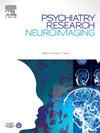Standardized weighted low-resolution electromagnetic tomography study of the amygdala activity in patients with comorbid major depressive disorder and anxiety symptoms
IF 2.1
4区 医学
Q3 CLINICAL NEUROLOGY
引用次数: 0
Abstract
Major depressive disorder (MDD) often coexists with anxiety disorders or symptoms, as identified by previous functional magnetic resonance imaging (fMRI) studies. These studies have found abnormal amplitudes of low-frequency fluctuations (ALFF) in the amygdala, which serve as traits and state markers of MDD. This study used standardized weighted low-resolution electromagnetic tomography (swLORETA) technology to explore amygdala markers in patients with comorbid MDD and anxiety. Participants included patients with MDD comorbid with anxiety symptoms (MDD group) and healthy controls (HC group) who completed the Beck Depression Inventory-II (BDI-II) and the Beck Anxiety Inventory (BAI). EEG data collected under resting state, happiness recall, and depressive recall tasks were converted into current-source density (CSD) values using swLORETA to assess amygdala activation. The results indicated higher beta2, beta3, and high beta levels in both the left and right amygdalae during the resting state in the MDD group than in the HC group. Similarly, elevated levels of beta2, beta3, and high beta were observed in the left and right amygdalae of the MDD group during happiness and depressive recall tasks. These findings support the presence of hyperactivity in the amygdala under resting state and emotional tasks in patients with comorbid MDD and anxiety symptoms.
对合并重度抑郁症和焦虑症状患者杏仁核活动的标准化加权低分辨率电磁断层扫描研究。
根据以往的功能磁共振成像(fMRI)研究发现,重度抑郁症(MDD)往往与焦虑症或焦虑症状并存。这些研究发现,杏仁核的低频波动(ALFF)振幅异常,可作为 MDD 的特征和状态标记。本研究采用标准化加权低分辨率电磁断层扫描(swLORETA)技术来探讨合并 MDD 和焦虑症患者的杏仁核标记。参与者包括合并焦虑症状的 MDD 患者(MDD 组)和健康对照组(HC 组),他们都完成了贝克抑郁量表-II (BDI-II) 和贝克焦虑量表 (BAI)。使用 swLORETA 将静息状态、快乐回忆和抑郁回忆任务下收集的脑电图数据转换成电流源密度 (CSD) 值,以评估杏仁核的激活情况。结果表明,在静息状态下,MDD 组左右杏仁核中的β2、β3 和高β水平均高于 HC 组。同样,在进行快乐和抑郁回忆任务时,也观察到 MDD 组左右杏仁核中的β2、β3 和高β水平升高。这些研究结果表明,合并有 MDD 和焦虑症状的患者的杏仁核在静息状态和情绪任务中存在过度活动。
本文章由计算机程序翻译,如有差异,请以英文原文为准。
求助全文
约1分钟内获得全文
求助全文
来源期刊
CiteScore
3.80
自引率
0.00%
发文量
86
审稿时长
22.5 weeks
期刊介绍:
The Neuroimaging section of Psychiatry Research publishes manuscripts on positron emission tomography, magnetic resonance imaging, computerized electroencephalographic topography, regional cerebral blood flow, computed tomography, magnetoencephalography, autoradiography, post-mortem regional analyses, and other imaging techniques. Reports concerning results in psychiatric disorders, dementias, and the effects of behaviorial tasks and pharmacological treatments are featured. We also invite manuscripts on the methods of obtaining images and computer processing of the images themselves. Selected case reports are also published.

 求助内容:
求助内容: 应助结果提醒方式:
应助结果提醒方式:


